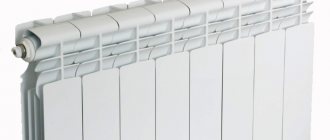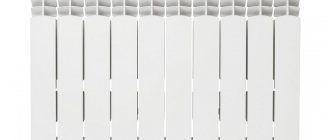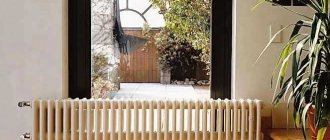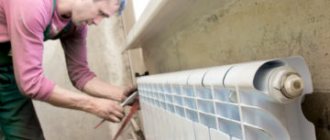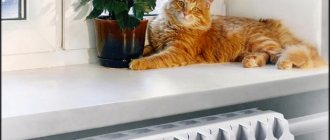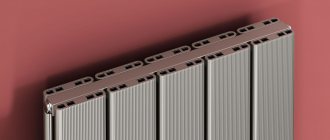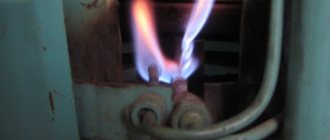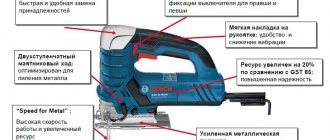When purchasing components for an autonomous heating system, batteries can account for up to 50% of the cost. Aluminum heating radiators will help reduce costs, since they cost approximately 30% less than their bimetallic counterparts and are comparable in cost to steel ones. However, the choice of this type of device must be taken responsibly and study all the pros and cons.
High-quality aluminum heating radiators provide excellent heat transfer, look attractive, and are easy to install and operate. At the same time, the technical characteristics of not all models are suitable for installation in apartment buildings and private buildings with a closed heating system.
What are aluminum radiators?
Radiators that are similar in design can have very different characteristics. This is due to manufacturing technology and the integrity of the manufacturer, who independently selects raw materials for their products.
Design and device
Aluminum radiators are a prefabricated structure made up of individual sections. Panel heating devices are not made from aluminum due to the properties of the material.
Most often on sale there are batteries assembled from individual elements already at the factory. The technological chain involves strength testing with maximum permissible pressure. Buying a ready-made battery of 4, 6, 8, etc. assembled sections, you are more likely to get a high-quality product.
Types of batteries by design
There are two types of batteries: collapsible and non-removable.
Collapsible sectional radiator
Non-separable model
In the first case, the sections are connected with threaded bushings, and sealing is carried out with silicone, rubber or paronite gaskets.
The joints are the weak link of the product:
- during heating/cooling cycles, depressurization of joints is possible due to regular changes in dimensions caused by thermal expansion;
- It is impossible to visually determine what material the gasket is made of.
Rubber gaskets can withstand system pressures of up to 6 atm and temperatures of up to 90 °C, which is only sufficient for individual heating systems in a private home. Paronite gaskets fully satisfy the requirements for reliability and durability for apartment buildings, but it is impossible to be sure that this particular design is used.
The advantage of collapsible radiators is the ability to replace a section if it is destroyed.
Monolithic (non-separable) radiators are resistant to pressure drops, since the individual sections are factory welded together. However, if there is a malfunction, the entire battery will have to be replaced. On the other hand, the work of a technician and the cost of a spare section may bring the cost of repair closer to the purchase of a new battery.
Comparison of parameters and qualities of bimetallic and aluminum heating radiators
Raw materials used
In almost all enterprises, radiators are produced on automated lines, eliminating the human factor. The quality of the product depends mainly on the raw materials used.
The best radiators are made from so-called highly purified primary aluminum, containing a minimum of impurities. To give the alloy the necessary properties, the following are added to it: magnesium, manganese, zirconium, scandium, which affect the individual properties of the metal. Radiator compositions should contain from 0.5 to 10% silicon. Its introduction prevents cracking under the influence of external factors (pressure and temperature).
In small enterprises, in order to reduce costs, they use secondary aluminum obtained by melting scrap. It is impossible to predict the exact chemical composition of the metal, the presence of additives and the properties of the alloy. It is not advisable to purchase Chinese-made products for installing batteries in apartment buildings. Such products are also used with caution in private buildings, where depressurization can lead to great material damage.
Installation process
In general, you should entrust the work of installing a radiator to a qualified specialist. But, knowing all the features, you can control the process yourself.
The installation process consists of several stages:
- Assembly. It is carried out before the entire heating system is installed. At the outer section, auxiliary equipment is installed: plugs, plugs, locking devices, and so on.
- Determination of attachment points. Recommendations for battery placement should be strictly followed to ensure maximum performance of the device.
- Installation of brackets. These elements are fixed with dowels. If desired, a cement solution is used as a fastening material.
- Battery installation. The mounting hooks must be installed so that they are located between the sections of the device. The lower parts have their own holders to prevent sagging. It is very important that the radiator is installed strictly horizontally, for which you need to use a level.
- Connection to the system. Depending on how the sections of the device are located, the heat pipes can be connected by one or two connections. The supply pipes must have a valve or thermostat. In order for all sections to warm up evenly, it is imperative to bleed the remaining air from the system.
Installation of heating equipment is not difficult. If the owner of the house does not have enough experience, it is recommended to seek help from specialists, which will guarantee long and efficient operation of the heating system. Learn how to insulate a wooden floor by following the link.
Types of batteries by production technology
Radiators are manufactured using one of two methods:
- injection molding;
- extrusion of softened raw materials.
If everything is clear with casting technology, then the production of radiators using the extrusion method occurs using a different method.
On production lines, blanks of section ribs are separately obtained by pressing the softened alloy in special molding machines. Next, the ribs are welded to the collectors. By the presence of a seam at the joints, it can be determined that the battery is made by extrusion.
Welding seam indicating extrusion manufacturing. In cast radiators there are no seams between the collectors and fins.
Important! Extruded radiators are cheaper and have poorer technical characteristics compared to cast products. Because of this, sellers can mislead buyers by selling cheap (extrusive) goods at the price of cast ones.
Anodized radiators
Well-known manufacturers necessarily protect the internal cavities of the radiator, preventing the formation of hydrogen upon contact between aluminum and coolant. The phenomenon is dangerous due to an increase in pressure in the system and destruction of the battery housing, pipelines or parts of the heating boiler.
Technologically, protection is carried out by electrochemical anodizing in baths with special solutions. After processing, a film is formed on aluminum that is not subject to chemical interaction with the coolant. Anodized radiators are the best solution, but their cost is usually several times higher.
Comparison of technical characteristics
Characteristics important for comparative analysis are collected in the table.
| Characteristic | Production method | |
| Cast | Extrusive | |
| Heat transfer of 1 section for radiators with a section height of 500 mm, W* | 80–210 | up to 200 |
| Working pressure, atm | 10–16 | 6–10 |
| Crimping pressure, atm | 15–20 | 10–15 |
| Breaking pressure, atm | 60–100 | 40–50 |
| Operating coolant temperature, °C | up to 120 | up to 100 |
| Manufacturer's warranty, years | 10–25 | 5–10 |
*Heat transfer is measured at a temperature difference between the coolant and air in the room of 70 oC.
Tubular view
They look like a standard structure of pipes and steel through which high-temperature water flows. Their production costs are higher, so the price is higher than that of panel radiators. Fairly low water pH - from 8 to 9. Withstands pressure from 9 to 14 bar. Thermal power is 1300 to 1500 Watt.
Tubular steel radiators have similar pros and cons to panel radiators. However, there are two different indicators: they withstand more pressure and are more expensive.
Advantages and disadvantages of aluminum radiators
The positive and negative aspects of aluminum radiators should be assessed according to the consumer qualities that are subjectively perceived by the consumer and the technical characteristics that are important for installation companies and operating organizations.
Table. Assessment of consumer properties of aluminum radiators.
| Advantages | Flaws |
| The price is lower compared to bimetallic analogues | Presence of low-grade products on sale |
| Attractive appearance, various designs, incl. factory painted in different colors (delivery upon pre-order) | The need for periodic bleeding of formed gases |
| Good heat dissipation | Restriction on use in multi-family buildings |
| Minimal maintenance - convection currents prevent dust from accumulating on the edges of the sections | The likelihood of leaks and the need to repair radiators assembled from separate sections |
| Availability of control devices | |
| Low inertia, heating begins immediately after the coolant is supplied. |
Detailed comparison of steel and aluminum radiators
Table. Features of design and technical characteristics.
| Advantages | Flaws |
| The characteristics of products from well-known manufacturers allow radiators to be used in any conditions | Impossibility of using inexpensive low-quality products in apartment buildings |
| Light weight, allowing installation on non-permanent partitions | Mandatory equipment for automatic air vents, even for anodized models that lose their properties over time |
| Standardized dimensions allowing you to select the size to fit the existing supply pipe system | |
| Availability of models with side, bottom and diagonal connections, which is important when installing a heating system | |
| Small internal volume of sections, reducing the amount of coolant in the system |
Product packaging
To make the right choice of aluminum radiators, you need to monitor the product package.
Standard kit includes:
- left-hand and right-hand plugs;
- Mayevsky valve (is a valve for bleeding air from the heating system);
- brackets;
- racks;
- gaskets for sealing;
- Ball Valves.
The connection of aluminum radiators should only be carried out by specialists who have permission for such activities. It is strictly not recommended to do this work on your own. As for installing batteries, this must be done in accordance with the technical instructions supplied with the products.
How to choose aluminum radiators
Minimum power
To accurately calculate the total thermal power, specialists carry out a thermal engineering calculation, which takes into account:
- long-term average annual climate indicators in the region of residence;
- thermal conductivity of building materials of walls, ceilings and building foundations;
- quality of insulation;
- glazing area, its characteristics, frame material, number of glasses in the package and cardinal directions where the windows face;
- area and volume of premises.
Losses are taken into account depending on the method of installation of radiators. For example, installation under a window sill reduces productivity by 4%, and in a wall niche by 7%. The screen has a similar effect on heat transfer, reducing it by 7–8%.
Changes in the thermal power of the radiator depending on the placement and presence of a screen.
Below we will present a calculator for such a calculation, but first we suggest you familiarize yourself with a simpler and more common method.
In most cases, for buildings made in accordance with Building Codes and Regulations, it can be assumed that heating one square meter of premises will require a thermal power of 100 W. Sometimes they are calculated by volume, then an indicator of 50 W/m3 is chosen.
Example. The area of the house is 100 m2, and the ceiling height is 2.7 m. In this case, you will need to install radiators with a total power of 10 kW.
Next, for the calculation, we study the product passport, which indicates the power of one section, for example, 180 W. Thus, it is necessary to divide the required minimum power by the performance of one section: 10,000/180 = 55.5 sections.
There is another way: it is believed that heating 2 m2 requires 1 radiator section. If we divide the area of 100 m2 by 2, we get approximately the same figure - 50 sections.
Advice! To avoid having to heat the coolant in a private home to a temperature of 80-95 oC, we recommend providing a 10% reserve for the power supplied by the batteries. This will allow you to operate the boiler and all elements of the heating system in a “gentle” mode, which will significantly extend the service life of each element.
Operating pressure
Almost any commercially available aluminum radiators are suitable for installation in private homes.
The working pressure in individual heating systems of a 2-3 storey building is limited by the characteristics of the boilers; they are designed for a pressure of up to 3.5 atm.
In private homes, systems are filled with clean water or antifreeze; this eliminates chemical reactions; the walls of radiators do not thin out over time, which means they will not collapse due to increased pressure.
In apartment buildings, a working pressure of up to 8-10 atm is created to circulate the coolant. It is necessary to raise the coolant to the upper floors and overcome the hydraulic resistance to fluid flow. At the time of annual pressure testing, the pressure is increased to 15 atm, identifying possible coolant leaks, and during water hammer, up to 30 atm can be applied to the radiators.
Based on these parameters, heating radiators are selected
Important! For apartment buildings, radiators are purchased that are designed for an operating pressure of 10-16 and pressure testing up to 20 atm.
Center distance
The center distance must be known for ease of installation, especially when replacing radiators. Parameter is important
(see photo below), when the supply pipe is connected to the upper collector of the battery, and the coolant is removed from the lower one. If the distance does not match, then additional turns will have to be made, which worsens the appearance of the structure.
Diagonal connection.
In most cases, the piping pipes are located at a distance of 350 or 500 mm. Based on this, radiators are purchased; there is no need to weld or solder additional turns. The parameter is usually indicated in the name of the convector, for example, Royal Thermo Revolution 500. The value 500 is the center distance.
With a bottom or side bottom connection, take into account the possibility of connecting pipes to the radiator from the desired side; the center-to-center distance in this case does not matter.
Dimensions
The geometric dimensions of radiators directly affect heat transfer (power). However, there are restrictions during installation:
- the distance from the floor should not be less than 70-100 mm;
- the distance between the battery and the window sill is chosen to be at least 80 mm;
- 80 mm is left to the side walls, and about 30 mm to the wall of the house.
If the requirements are not met, convection will deteriorate, which reduces the performance of the device.
Exact installation recommendations are indicated in the operating instructions or data sheet for a specific model.
Detailed diagram from the instructions using the Royal Thermo Vittoria as an example.
When purchasing, take into account the thickness and width of the assembly, since if the window sill is not wide, the radiator will extend beyond it, which will worsen the design of the room.
Calculation of the number of sections
To effectively heat a particular room, a certain number of battery sections will be required. If there are not enough of them, the system will not be able to warm up the home in winter. To correctly calculate the quantity, there are special formulas.
The first option is by area. This method is used if the ceiling height in the room is standard, not higher than 2.6 m.
The formula looks like this: N = S × 100/Q, where:
- S is the area of the room;
- Q is the thermal power parameter of section 1;
- N is the required number of sections.
It is recommended to round up, with a margin.
The second option is a calculation for a room with a non-standard ceiling height, by volume. Based on the recommendations of SNiP, heating 1 m3 of area requires 41 W of equipment power. The formula is: N = V × 41/Q. The letter “V” indicates the volume of the room.
Even if the calculations were made incorrectly, you should not be upset. Aluminum batteries can be expanded, that is, additional sections can be added to them. To do this, you will need a special key for radiators, and the blocks themselves are connected using steel nipples.
The best known manufacturers and models: characteristics and prices
The most widely used brands are:
- Oasis . The Chinese concern was founded in 2006, so the factories are equipped with modern equipment, which guarantees quality. Some products are produced under licenses from Western European companies.
- Monlan , a Chinese company focusing on the market of the Russian Federation and some CIS countries. Economy class products are intended only for private homes, since the manufacturer saves on materials, the walls of the sections are thin and are not designed for high pressure. The reliability of work in private homes is not satisfactory. When purchasing, check the appearance - the color of the radiators may vary even in the same batch.
- Purmo , Finland, a recognized leader in the production of heating equipment.
- Tessen is one of the best Chinese manufacturers. The walls of the radiators are sufficiently thick; the technical characteristics of some models allow installation in apartment buildings.
- Global Radiatori , the concern's factories are located in European countries, cheap products are delivered from China.
- IPS , Italy. Produces radiators of the highest quality. Factories are located in Italy and Slovakia. The price of products is high, which limits the distribution of products.
- Rifar , Russia. The production is located in the Orenburg region. The manufacturer insures its products against destruction, but to obtain it, the installation of products must be carried out by a specialized organization.
- Royal Thermo , Russia. All products undergo quality control; aluminum radiators are necessarily processed using anodizing technology.
- Radena , Italy. All production is located in Italy, which gives additional confidence in quality. If other countries are indicated in the passport, this means counterfeit products.
- Mandarino , a Russian company operating under an Italian license. High quality is a distinctive feature of the products.
The most in demand are white radiators with a number of sections from 4 to 10 and with an interaxial distance of 350 or 500 mm - these are the products that are on display in construction supermarkets.
How to actually choose the cheapest heating radiators on the market
Below are the models that are leaders in sales and consumer ratings.
Royal Thermo Biliner Alum 500
The plant of the Russian company is located in the Vladimir region. The manufacturer draws attention to the unusual aerodynamic shape of the products, developed by the Italian company IPG Design Studio. Additional fins provide high performance. The center distance of the model is 500 mm. The gaskets are made of cotton with the addition of silicone and graphite, which allows them to withstand coolant temperatures up to 130 °C. Dimensions: 580x80x87 mm.
Painting occurs in 7 stages, which ensures the stability of the layer for the entire period of operation. The warranty for the model is 10 years. Royal Thermo Biliner Alum 500 is one of the best aluminum radiators for a private home and apartment.
Royal Thermo Revolution 500
Radiators of the series are presented only in white. The wave-like shape of the ribs ensures increased convection of air flows.
The paint is completely safe and is highly resistant, so the series radiators can be installed in bedrooms and children's rooms, as well as in wet areas. Dealers are located in dozens of cities.
STOUT BRAVO 500
A series of Italian radiators with a center distance of 500 mm and side connections, painted in RAL9010 and RAL9016 colors. The manufacturer notes the simple installation of the radiator and the availability of control valves, since the connecting dimensions are standard for similar products. The aluminum body provides low inertia - the sections quickly heat up when the boiler is turned on.
An important condition set by the manufacturer: the quality of the coolant must meet the requirements of SO-153-34.20.501-2003, which is difficult to achieve for houses connected to old heating systems. The warranty may not apply if it is proven that the requirements of the document have not been met.
Global VOX R 500
Radiators are produced by an Italian company founded in 1971. The model was developed taking into account Russian conditions (low water treatment of the coolant and pressure drops in the system).
Heat transfer measured at a difference in coolant and air temperatures of 50°C is 181 watts/section, and at a difference of 70°C - 276 W, which is the best indicator for devices of similar dimensions.
Rifar Alum 500
The line includes radiators of the same shape, but different in axial distance. Reliability is achieved by milling the end of the section for a specially designed gasket. The locking connection is patented by the manufacturer. Radiators with a number of sections from 4 to 14 are commercially produced.
The Alum series includes Ventil types for bottom connection. Rifar Alum Flex – radiators with a radius of curvature for installation along rounded walls.
Radena 500
The radiator was designed by Italian designers and has an oval channel section for coolant circulation, which increases the contact surface area and, accordingly, the heat transfer of the section, amounting to 195 W.
ROMMER Al Optima 500
The batteries are produced by a Russian brand at a Chinese factory. Quality is ensured by automatic production lines and careful output control of all product parameters. Model color is white.
Features of the model: wall thickness 1.8 mm, anti-corrosion treatment of internal surfaces, two-stage painting with a mandatory primer.
Among the disadvantages are the low heat transfer of one section - 133 W and the maximum coolant temperature of 110 °C.
Mandarino 500
The peculiarity of the product is that the series is assembled from square or round pipes without fins and has a one-piece design with anodic oxidation of surfaces. The products look unusual and elegant.
Prices: summary table
| Model | Heat transfer per section, Vit | Working pressure, atm | Breaking pressure, atm | Average price per section | Price for 1,000 W of power |
| Royal Thermo Biliner Alum 500 | 175 | 16 | 48 | 760 | 4 300 |
| Royal Thermo Revolution 500 | 170 | 20 | 50 | 850 | 5 000 |
| Global VOX R 500 | Up to 276 | 16 | 48 | 720 | 5 000 |
| Rifar Alum 500 | 186 | 15 | 50 | 750 | 4 000 |
| Radena 500 | 195 | 15 | 40 | 960 | 4 900 |
| ROMMER Al Optima 500 | 133 | 12 | 24 | 388 | 3 000 |
| Mandarino 500 | 210 | 15 | 25 | 1600 | 7 000 |
When choosing aluminum radiators, we primarily focus on technical characteristics and operating conditions. The right choice will allow you to avoid troubles in the form of structural destruction and flooding of premises, which can result in high repair costs.
